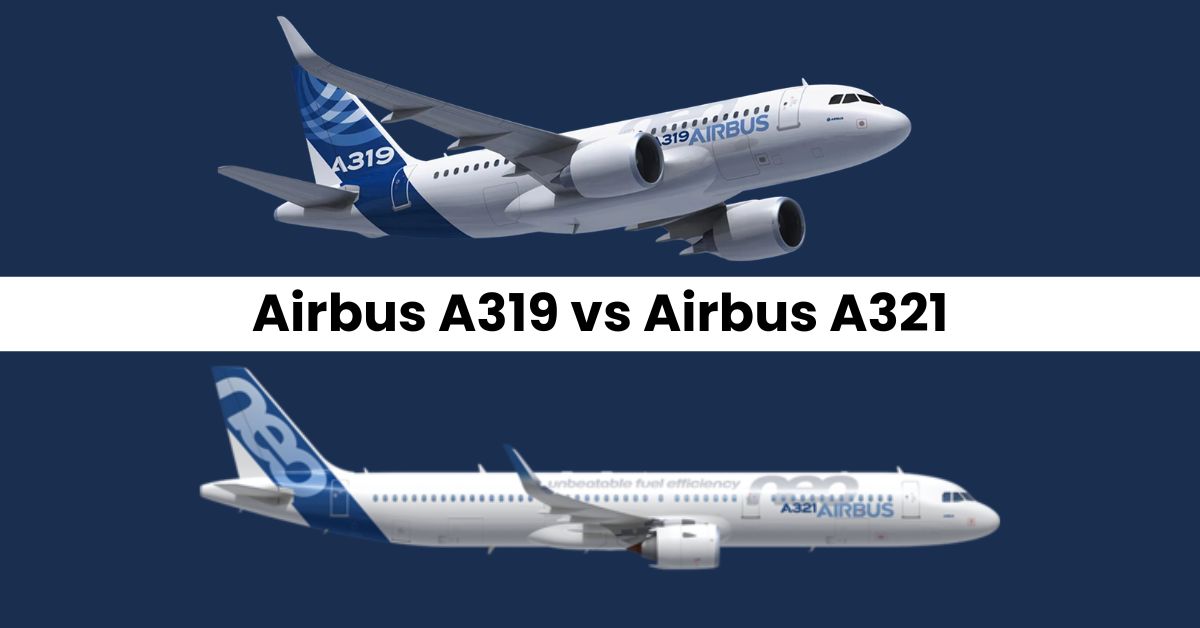In the world of commercial aviation, Airbus stands out as a leading manufacturer, with its A320 family of aircraft being particularly popular among airlines worldwide. Two notable members of this family, the Airbus A319 vs A321, serve as perfect examples of Airbus’s dedication to versatility and efficiency. Though they share many similarities, their differences are crucial for airlines when deciding which jet better suits their operational needs.
Airbus A319 vs A321: Similarities
Both the Airbus A319 and A321 are built on the innovative design principles of the A320 family. They feature a digital fly-by-wire system, a significant advancement over the traditional manual controls found in many other aircraft. This system uses computers to interpret pilot inputs, enhancing safety by adding redundancy and reducing human error. Additionally, the introduction of a sidestick instead of a yoke offers pilots more cockpit space and comfort.
Inside the cabin, passengers will find a single aisle with a typical 3-3 seating arrangement in economy class. Business or first-class sections usually feature a more spacious 2-2 setup. These configurations ensure passenger comfort across both models, maintaining a consistent experience within the A320 family.
Airbus A319 vs A321 Comparion
Here’s a detailed comparison table that highlights the key differences and similarities between the Airbus A319 vs A321:
| Specification | Airbus A319 | Airbus A321 |
|---|---|---|
| Overall Length | 33.84 m | 44.51 m |
| Cabin Length | 23.78 m | 34.44 m |
| Fuselage Width | 3.95 m | 3.95 m |
| Max Cabin Width | 3.70 m | 3.70 m |
| Wing Span (Geometric) | 35.80 m | 35.80 m |
| Height | 11.76 m | 11.76 m |
| Track | 7.59 m | 7.59 m |
| Wheelbase | 11.04 m | 16.90 m |
| Max Seating Capacity | 160 | 244 |
| Typical 2-Class Seating | 120-150 | 180-220 |
| Cargo Capacity Underfloor | 4 LD3-45W + 2.3 m³ bulk | 10 LD3-45W |
| Max Pallet Number Underfloor | 4 | 10 |
| Water Volume | 32 m³ | 59 m³ |
| Range | 6,850 km | 7,400 km |
| Max Operating Speed (Mmo) | M0.82 | M0.82 |
| Ramp Weight | 75.90 tonnes | 97.40 tonnes |
| Take-off Weight | 75.50 tonnes | 97.00 tonnes |
| Landing Weight | 63.90 tonnes | 79.20 tonnes |
| Zero Fuel Weight | 60.30 tonnes | 75.60 tonnes |
| Fuel Capacity | 26,730 litres | 32,940 litres |
This table effectively encapsulates the primary differences and similarities between the Airbus A319 vs A321, providing a clear overview of their dimensions, capacities, and performance characteristics.
What’s Make Difference : Airbus A319 vs A321
The most noticeable difference between the A319 and A321 is their size. This distinction directly affects passenger capacity and cargo volume, with the A319 accommodating between 110 and 160 passengers and the A321 capable of carrying from 180 up to 244 passengers in a high-density layout. Cargo capacity also varies significantly, with the A319 holding up to 27.62 cubic meters and the A321 up to 51.73 cubic meters.
Despite these differences, the two models share many physical dimensions, such as wingspan, wing area, and tail height, underscoring their familial ties and operational similarities.
“For an in-depth comparison between the Airbus A319 and its sibling, the A320, exploring their unique features and operational capabilities, check out our detailed Article Airbus A319 vs A320.”
Airbus A319 vs A321: Performance Differences
Performance is another area where the A319 and A321 diverge, especially regarding range. The A319 boasts a range of 3,750 nm, which remains unchanged even in its NEO (New Engine Option) variant. Conversely, the A321’s range was originally 3,200 nm but has significantly increased to 4,000 nm with the NEO upgrade, making the A321NEO a more appealing option for airlines looking to expand their service areas.
Take-off and landing distances are also different, which could impact operations at smaller airports. The A319 requires less runway for both take-off and landing compared to the A321, offering greater flexibility in airport selection.
Airbus A319 vs A321 Which Aircraft is ‘Best’?
Choosing the “best” aircraft between the Airbus A319 vs A321 really depends on what an airline or passenger values most. The A319, with its smaller size, is perfect for airlines that need a versatile aircraft capable of landing at smaller airports or serving routes with less passenger demand. Its ability to seat between 120 to 160 passengers makes it an excellent choice for short to medium-haul flights, offering a balance of comfort and efficiency.

On the other hand, the A321 caters to airlines looking to transport a larger number of passengers, up to 244, without sacrificing the comfort and efficiency Airbus is known for. Its longer range and higher capacity make it ideal for busier routes and airports, allowing airlines to maximize their revenue on each flight. The A321’s ability to carry more cargo is also a significant advantage for commercial operations.
In essence, the A319 offers intimacy and flexibility, perfect for niche markets and specific operational strategies, while the A321 provides the capacity and range needed for more extensive network operations and high-demand routes. Therefore, the “best” aircraft is the one that aligns with the specific needs and goals of its operators, making both the A319 and A321 invaluable in their own right within the Airbus family.
Conclusion
In conclusion, the Airbus A319 and A321 each serve unique roles within the Airbus A320 family, catering to different segments of the air travel market with their distinct features. The A319 shines as a compact, efficient option for airlines operating shorter routes or needing to access smaller airports, offering flexibility and cost-effectiveness without compromising on passenger comfort. On the other hand, the A321 stands out for its ability to carry a larger number of passengers over longer distances, making it a preferred choice for carriers looking to maximize capacity and range on busier routes.
FaQs
What are the main differences between the Airbus A319 and A321?
Can pilots fly both the A319 and A321?
How do the cabin experiences compare between the A319 and A321?
Are there significant differences in cargo capacity?
Is the A321 suitable for long-haul flights?



